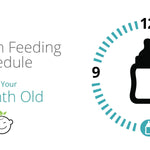2-Month-Old Feeding Schedule

by Baby Earth
Oct 30, 2018
When deciding when and how to feed your baby, there are multiple options to choose from. Some parents choose to feed on demand, some parents follow a regimented schedule and some parents do a mix of both.
Feeding on demand means that parents don't adhere to a strict schedule but rather allow their child to guide when it's time to eat. Following a strict feeding schedule means that parents follow a feeding timeline and don't deviate from it. A mix of both on-demand and scheduled feedings means that the parents usually feed on a schedule, but if their child is extra hungry, they will adjust the schedule as needed.
Shop
Article Continues Below Advertisement
For the parents who have decided to do scheduled feedings or a mix of on-demand and scheduled feedings, I've created a sample schedule for both formula fed babies and breastfed babies that will fit the average 2-month-old's feeding needs.
Feeding Cues
While some parents adhere to a strict schedule, I would recommend against keeping such a rigorous schedule that you miss important feeding cues. During growth spurts, your child will go through periods when he or she is hungrier due to their accelerated growth. It's important to adjust your schedule to meet those needs; otherwise, you will have a very hungry and fussy child on your hands.
Feeding cues include things like sucking on fingers or hands, making noises, kicking his or her legs, and finally, fussing or crying.
Hunger cues usually go in stages, moving from sucking on fingers in the early stages of hunger to crying or fussing when the child is very hungry or in the late stages of hunger.
Read more
Article Continues Below Advertisement
How Much to Offer at Each Feeding
At 2 months of age, your formula fed baby will be eating four to six ounces at each feeding; however, the amount of food your child needs will depend on his or her weight. Your child should be eating approximately 2 1/2 ounces of formula for each pound of body weight per day. So, if your child weighs 11 pounds, he or she should be eating 27 1/2 ounces of formula in a 24-hour period.
Figuring out how much to feed your breastfed baby isn't as much of an exact science as formula feeding. The older your child gets, the more efficiently he or she will feed, so an efficient baby might empty your breast in five minutes while a less efficient child will take as much as 20 minutes. If you're not sure if your baby is getting enough at each feeding, look for the following signs:
- Your breasts feel softer after the feeding
- Your baby seems calm and satisfied.
- Your baby is wetting at least six diapers a day.
- Your baby is continuously gaining weight.
As your child gets older and eats more at each feeding, you can slowly space your feedings out a bit further, but once again, pay attention to your child and adjust your schedule to meet his or her needs.
Also, as your child gets older, he or she will be able to sleep longer at night (hopefully!), so if your child doesn't wake up for his or her normal, scheduled feeding, don't worry and just try to enjoy the extra sleep.
Sample Breastfeeding Schedule for a 2-Month-Old
Feeding 1: 6:30 a.m.
Feeding 2: 9:00 a.m.
Feeding 3: 11:30 a.m.
Feeding 4: 2:00 p.m.
Feeding 5: 4:30 p.m.
Feeding 5: 7:00 p.m.
Feeding 6: 9:30 p.m.
Feeding 7: 12:00 a.m.
Feeding 8: 4 a.m.
Sample Formula Feeding Schedule for a 2-Month-Old
Feeding 1: 6:30 a.m.
Feeding 2: 9:30 a.m.
Feeding 3: 1:30 p.m.
Feeding 4: 4:30 p.m.
Feeding 5: 7:30 p.m.
Feeding 6: 10:30 p.m.
Feeding 7: 2:30 a.m.
The above schedules are just a sample of what your feeding schedule may look like. You are the parent and you know your child best, so adjust your schedules according to your child needs.
Read more
This two-month feeding schedule is just part of our continuing baby feeding schedule series. Make sure to read our other helpful posts for your two-month-old.
More Feeding Guide Articles
- Feeding Schedule for Your 1-Month-Old
- 2-Month-Old Feeding Schedule
- 4-Month-Old Feeding Schedule
- 6-Month-Old Feeding Schedule
- 9-Month-Old Feeding Schedule
- 12 Month Old Feeding Schedule





